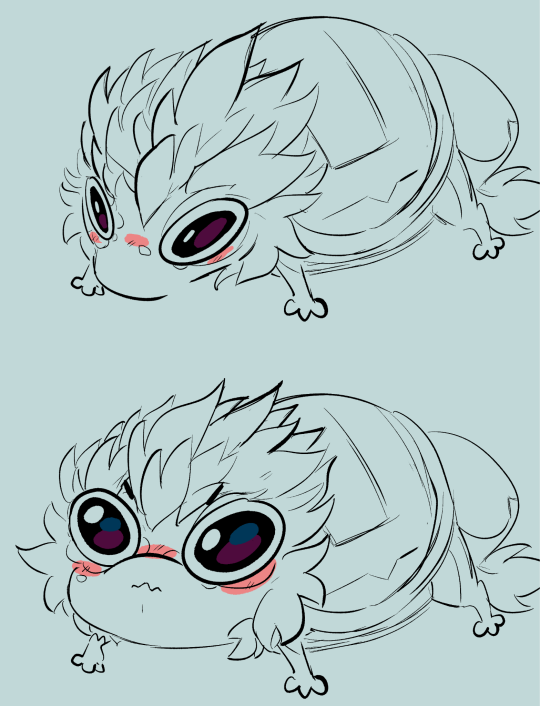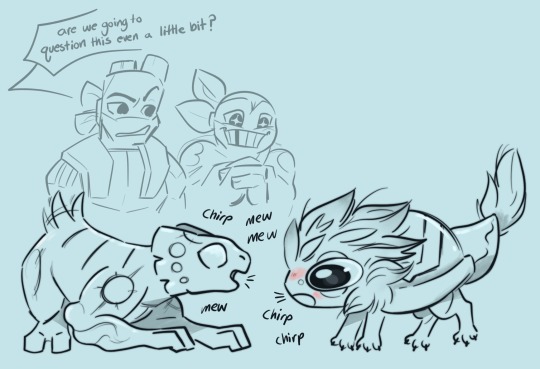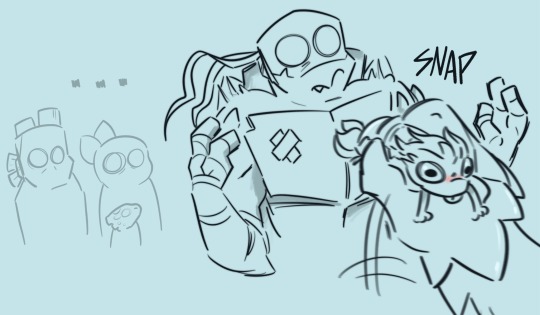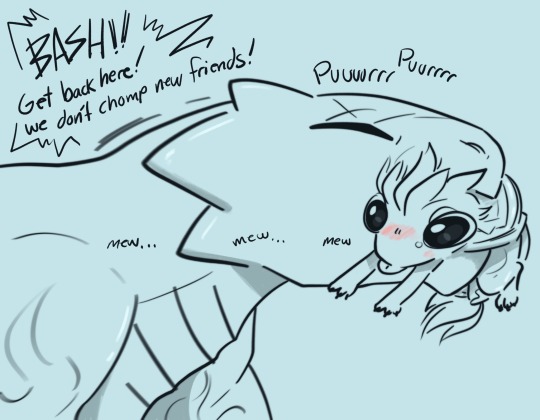#feel free to tell ot show me where this may lead ^v−☆
Explore tagged Tumblr posts
Note

Will the turts take a wish from totally reliable wish dragon Dai?




They will, once they can get them back (๑˃̵ᴗ˂̵) @sweeneydino
#the lingering instinct to carry smol dragon in mouth is a strong one for raphs dragons#Ruben has been a subject to the chomp carry many a time#dai is just getting the proper dragon protective treatment - but I would be lying if it wasn’t also a little bit of a game#feel free to tell ot show me where this may lead ^v−☆#cute to cute communication#Ruben 🤝 Dai#tmnt#rottmnt#my art#tmnt dragons#tmnt spitfire#spitfire asks#ask box#ask answers#art 4 others
590 notes
·
View notes
Text
If you think Cassandra betrayed Rapunzel because she’s evil, you haven’t been paying attention to the series
So, I know this has been said before, but apperently there are still many people in the fandom who firmly believe Cassandra either was evil all along, or she betrayed Rapunzel out of jealousy, ot because she wanted power. And that is just not the case.
There is a post about this already, but I just decided to expand a lot a little on it. On the central theme of the series: Protection vs. Freedom.
So, ever since the very first time we’re introduced to the Tangled world, the themes of Protection and Freedom are very apparent, mainly through two people who represent them; the King and the Queen. The King wants to protect Rapunzel at all costs, even if that means having a bunch of guars following her around all day, while the Queen trusts her to take care of herself and make the right decisions on her own.

Of course, the King’s actions are misguided and terribly unfair, which causes Rapunzel to sneak out without his knowledge, and this in turn makes him make an even harsher decision in order to keep her safe.

These themes are explored once more throught the series, but they are more evident in the final episode, when the King locks Rapunzel in a tower to protect her from Varian.

Meanwhile, Rapunzel’s mother expliains to her that, though her father’s actions were guided by love, they are still unfair.

Rapunzel then proceeds to sing a great song about freedom and how only she can decide what to do and who to be, and then she fights Varian, saves her mother, takes control of the black rocks, etc. and at the end her father learns that he needs to let her live her own life and stop trying to control her with the excuse of protecting her.

Now comes season two... And these themes show up once again since the very first episode. Remember, Eugene and Rapunzel are singing and running and just enjoying their freedom (mostly Rapunzel; Eugene just rolls with it). And then comes Cass, who is the only one with military training, the one who was enthrusted by the King himself with Rapunzel’s safety, and therefore this season’s embodiment of the Protection theme.

At first, Cassandra’s protection over Rapunzel is rather permisive, since she’s seen firsthand all the things Raps is capable of. But then she realizes there’s one thing Rapunzel is severily lacking: caution. She trusts practically anyone right after meeting them, be it the bird lady and her son, Stallion (Eye of Pincosta), the weird guy in the shell house or (most importantly) Adira. Cassandra is foil to Rapunzel in this regard; she doesn’t trust anyone. Especially Adira.
So, Cass can’t do much protecting of Rapunzel when it comes to combat because Rapunzel is pretty good at that herself (Challenge of the Brave, anyone?), so she feels like she needs to protect her from her own naiveté, especially since Raps often says she doesn’t need anyone to protect her (interpreted by Cassandra as Rapunzel not needing her).

And the whole episode of “Rapunzel and the Great Tree” is about Cassandra trying to prove that Rapunzel does need her; that she’s better than Adira, that she’s not just a servant to the princess, but also her friend and protector. But you know what’s sad? That Cassandra is instead proven wrong. She is a servant to her Princess and must follow her orders, she has to respect her decisions and step aside, and at the end of the day it is Adira and Rapunzel who save everyone while Cass only manages to get herself injured.
So how does this episode fits on the Protection vs. Freedom theme? Simple: Cass tried to protect Rapunzel by trying to take the decisions for her; saying things like that they can’t trust Adira and have to lose her, and trying to force Rapunzel into going along with it. But unlike the King, Cass isn’t some figure of authority; she can’t tell the princess what to do, so Rapunzel disregards her time and time again because she was free to do so. Trusting Adira, camping there for the night, singing the moon incantation... those were her decisions. Good? Bad? Who knows? But she took them freely.

Later, in “Rapunzel: Day one” it is revealed that Cass is still mad at Rapunzel because of the decisions she made, but she says herself that she won’t always be. Sure, maybe Cass could have saved them all by using the magic spear, we’ll never know, but at least Raps got them all out of there (mostly) unscathed.
Then comes the shell house, where Cass again tries to warn Rapunzel and she, as always, disregards her concerns, which of course leads to three episodes full of magic and danger, and to Cassandra getting into that mysterious room of which we still don’t know anything.
Finally, in “Destinies Collide”, we see Rapunzel and Eugene having a pretty interesting conversation.


Yeah, that conversation is obviously about Cass, and it pretty much foreshadows the ending of the season; Cassandra taking the moonstone because she wants to protect Rapunzel.
I mean, just look at this scene:


Cass doesn’t want anything to happen to Rapunzel because she’s her friend and she loves her too much to just watch as she gets killed. But she doesn’t say anything in that moment. She doesn’t protest any further. She doesn’t try to convince Raps not to trust Adira and go through with her plans. Why? Because Rapunzel hasn’t been lsitening to her all this time, so why would she start now?

Eugene goes through a similar phase, sure, but he eventually comes around and decides to trust Rapunzel to make the right choice, not because he’s not scared of what may happen to Rapunzel, but because throught the series he’s come to realize he needs to give Raps freedom (remeber, at first he wanted to settle down with her, and now he’s accepted that that’s the last thing on Rapunzel’s mind right now, and that what she wants is to see the world and have aventures). So Eugene’s decision is the Freedom theme in this episode.
Cassandra, on the other hand, is not willing to take that risk. It was probably a last second decision on her part. Regret, second-guessing her mission, realizing she loves her too much to let her go through that, who knows? It probably also has something to do with what she saw in the mysterious room. Perhaps she saw Rapunzel dying or turning evil because of the moonstone, but she probably didn’t believe it until it was confirmed by Adira.

Let’s also remember that she believes her destiny is to become a Royal Guard like her father; a hero who would do anything to protect the kingdom of Corona and the royal family .

The point is, Cassandra chose Rapunzel’s safety over her freedom of decision, while Eugene did the exact opposite. Does that make her a bad person? Does that make her evil?? No, of course not. She’s just misguided, just like the King was in the first season, and I’m sure she’ll come around during the next season.
So, anyways, thanks to reading through my (not so) little rant that is mostly meant to comfort myself and assure me that my favorite character in the show isn’t actually truly irredeamably evil :,v. I hope you enjoyed and that I was able to convince you.
#cassandra#tangled#tangled the series#analysis#season 2#protection vs freedom#she's not evil#shut up#you're evil
175 notes
·
View notes
Text
Analysis: The Significant Structural Elements and Thematic Forms of George Seremba’s ‘Come Good Rain’
The most significant structural element of Come Good Rain is evident from the very start - it is an autobiographical one man show. In the Playwright’s Note before the play, Seremba wrote “It had to be a one-man show, with a musician along to accompany me with the drums, through the tears and ruptures as I relived the horror of what had now turned into my therapeutic voyage” (8). This process was double-fold in the fact that for most of the versions of Come Good Rain that have been produced, Seremba has played himself (Seremba, 4; Budde and Seremba). This choice, and the production choices that followed, also drew on his African heritage and the Griot storytelling tradition (Budde and Seremba). Taking the journey through these traditional forms of Griot storytelling was part of his healing (Budde and Seremba). He was paying homage to not only his history and story of survival, but that of the country as well in a way that is reflective of the oral history traditions of African cultures. For many African peoples, Griots function as oral historians, poets, genealogists, and storytellers, and will educate and share these histories with communities through music, song, and storytelling (Winter, 646; Henrich, 25). Griots often made use of drums and other instruments to enhance their storytelling (and there are particular significances around the function of drums in African storytelling that will be explored in other posts) and so the musician onstage playing the drum and the flute throughout the play is of vital importance to the upholding the conventions of this tradition (Okoh).
The play also draws many allusions to both Christian and African legends and forms of belief, creating a type of mythic magic realism through their hybridization (Maufort, 96). The presence of both cultural influences shows the impact of Uganda’s (and Africa in general) colonial history. The play opens with George telling the folk tale of Nsimb’egwire, a young girl who is buried alive in the forest by her jealous stepmother and faces the ultimate struggle to survive, and this tale creates a framework around the play and parallels the struggle for survival that George faces at the end as he narrowly avoids execution and death (Seremba, 13). As he battles death, George once against calls upon her story in parallel with his as he feels a sense of kinship with her, and in the final scene of the play the framework is complete as George dreams of Nsimb’egwire’s evil stepmother running away because he is free at last (Seremba, 53, 63). Additionally, he likens her voice to a flute when he later recounts her tale again, and so this sense of kinship and her story is alluded to every time the flute is played throughout the play (Seremba, 18). On the other hand, the presence of Christian belief and parallels to the story of Lazarus are also drawn on in the play. There are multiple instances of praying to God throughout the play, and George’s Aunty tells him to “thank God and the rain” for his survival (Seremba, 61). George’s “dismemberment” as he shot to near death and then survival liken his story to the resurrection of Christ (Maufort, 95). Futhermore his emergence from the Namanve forest, which no one comes out of alive, seem reminiscent of Christ’s emergence from the cave.
The structural chronology of events and passage of time in the play also reveal where the significance of the story lies. Act 1 explores the development of the political environment of Uganda that lead to such a situation over many years, covering his childhood, the first rise and fall of Milton Obote, the rise and fall of Idi Amin, and the re-establishment of Obote (Seremba). The act ends upon his arrest by Ugandan soldiers (Seremba, 40). In constrast, all of Act 2 takes place over just a couple of weeks, from the night of Dec. 10th 1980 when he is shot in and escapes Namanve forest to his arrival in Kenya on Dec. 28, 1980 (Seremba). It creates the sense that the events of that night were as long and impactful as the rest of his life leading up to it put together.
References
Budde, Antje, and George Seremba. DRM331 Guest George B. Seremba part 2. University of Toronto. 25 November 2020. https://q.utoronto.ca/courses/181504/pages/av-come-good-rain-conversation-with-george-b-seremba
Henrich, Daniel J. “The griot storyteller and modern media”. South African Journal for Communication Theory and Research, vol. 27 iss. 1, 2001, pp.24-27. DOI: https://doi.org/10.1080/02500160108537921
Maufort, Marc. Transgressive Itineraries: Postcolonial Hybridizations of Dramatic Realism. Peter Lang, 2003. https://books.google.ca/books?id=qZtTwoWLnTsC&pg=PA95&lpg=PA95&dq=Nsimb%27egwire+folk+tale+africa&source=bl&ots=8v5JemveHU&sig=ACfU3U0xKAhzM5Dzb5mziLzkexzvRpWvZQ&hl=en&sa=X&ved=2ahUKEwim3_O0o8HtAhUFZN8KHezuBW4Q6AEwEnoECCAQAg#v=onepage&q=Nsimb'egwire%20folk%20tale%20africa&f=false
Okoh, Lize. “What Is a Griot and Why Are They Important?” Culture Trip. 24 May 2018. https://theculturetrip.com/africa/mali/articles/what-is-a-griot-and-why-are-they-important/
Seremba, George B. Come Good Rain. Playwrights Guild of Canada, 2019.
Winter, Yoad. “On the Grammar of a Senegalese Drum Language”, Language, vol. 90, no. 3. Linguistic Society of America. 2014. pp. 644-668. https://www.jstor.org/stable/24672041
0 notes